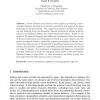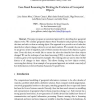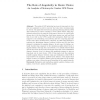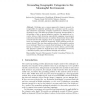COSIT
2009
Springer
14 years 6 months ago
2009
Springer
Abstract. I review theories and research on the cognitive processing of environmental distance information by humans, particularly that acquired via direct experience in the enviro...
COSIT
2009
Springer
14 years 6 months ago
2009
Springer
Movement patterns of individual entities at the geographic scale are becoming a prominent research focus in spatial sciences. One pertinent question is how cognitive and formal cha...
COSIT
2009
Springer
14 years 6 months ago
2009
Springer
Abstract.Abstract.Abstract. This paper proposes an automated approach for describing how geospatial objects evolve. We consider geospatial objects whose boundaries and properties c...
COSIT
2009
Springer
14 years 6 months ago
2009
Springer
Relation models have treated multi-holed regions relations either the same as hole-free regions relations, loosing this way the peculiarities of the holed topology, or with methods...
COSIT
2009
Springer
14 years 6 months ago
2009
Springer
For an autonomous physical agent, such as a moving robot or a person with their mobile device, performing a task in a spatio-temporal environment often requires interaction with ot...
COSIT
2009
Springer
14 years 6 months ago
2009
Springer
Abstract. The paths of 2425 individual motorcycle trips made in London were analyzed in order to uncover the route choice decisions made by drivers. The paths were derived from glo...
COSIT
2009
Springer
14 years 6 months ago
2009
Springer
We propose an empirical, perception-based evaluation approach for assessing the effectiveness and efficiency of longstanding cartographic design principles applied to 2D map displa...
COSIT
2009
Springer
14 years 6 months ago
2009
Springer
We present an approach to assist the smart environment design process by means of automated validation of work-in-progress designs. The approach facilitates validation of not only ...
COSIT
2009
Springer
14 years 6 months ago
2009
Springer
Conceptual neighborhood graphs are similarity-based schemata of spatial/temporal relations. This paper proposes a semi-automated method for deriving a conceptual neighborhood graph...
COSIT
2009
Springer
14 years 6 months ago
2009
Springer
Abstract. Ontologies are a common approach to improve semantic interoperability by explicitly specifying the vocabulary used by a particular information community. Complex expressi...




